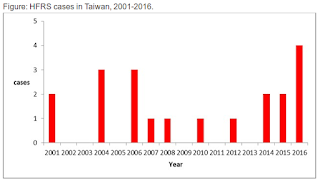#13,254
Taiwan (pop. 23.5 million) only reports a handful (avg. 0-4) of Hantavirus virus infections (see chart above) each year, with just 12 reported in the past decade.
The virus is contracted by humans primarily through the inhalation or ingestion of aerosolized rodent feces, urine, saliva.Scientists have identified dozens of viruses within the genus Hantavirus (named after the Hantaan River of Korea) from all around the world, with mortality that varies from 1%-2% for some varieties (i.e. Seoul Virus, Puumala Virus) to more than 30% for the North American Sin Nombre and South American Andes Virus.
In humans, there are two severe (sometimes fatal) diseases caused by Hantavirus: Hemorrhagic Fever with Renal Syndrome (HFRS) and Hantavirus Pulmonary Syndrome (HPS).HFRS is found in Europe, Asia, and Africa, while HPS is found in the Americas (North, Central and South). To date, all Hantavirus infections in the United States have resulted in HPS and not HFRS (see note at bottom of blog).
Except for some rare reports involving the South American Andes virus, there are no confirmed cases of human-to-human transmission of any of the Hantaviruses.From the Taiwan CDC website:
As this year’s first case of hantavirus hemorrhagic fever confirmed in Taiwan, public urged three “Don’ts” to ensure rodent control and ward off hantavirus infection ( 2018-04-09 )
On April 3, 2018, the Taiwan Centers for Disease Control (Taiwan CDC) announced this year’s first case of hantavirus hemorrhagic fever in a 44-year-old male who resides in northern Taiwan and works in the food and beverage industry. The case’s primary areas of daily activities include places around his work place, residence and the nearby mountain. He had not recently traveled domestically and internationally.
On March 9, he developed symptoms, including fever and dizziness. When his symptoms persisted despite seeking medical attention several times, he was referred to a hospital and hospitalized for further treatment. After the hospital reported the patient as a suspected case to the health authority on March 14, infection with hantavirus hemorrhagic fever was confirmed in the case on April 3.
As of now, the case’s conditions have been improved and he has been discharged from the hospital. None of the family members residing in the same household with the case has developed suspected symptoms.
To reduce the risk of further transmission, the local health authority has implemented a number of rodent control measures around the case’s residence, and provided relevant health education to the residents in the neighborhood.(Continue . . . )
While relatively rare, every year the U.S. reports between 10 and 50 Hantavirus Pulmonary Syndrome (HPS) cases, of which, roughly 35% prove fatal. Cases have been reported in 35 states (see map below), with 96% of all cases reported west of the Mississippi River.
 |
| Credit CDC |
With the arrival of spring (still an unconfirmed rumor in some parts of the country), this is the time of year people are beginning to clean out barns and sheds and are more likely to come in contact with rodent excreta.
The CDC offers some specific advice (see Cleaning Up After Rodents) on how to do it more safely.
Although New World Hantaviruses produce HPS (but not HFRS) in humans, we did have a close call last year when the Old World Seoul Virus was imported into the United States and Canada (see CDC HAN Advisory: Seoul Virus Outbreak Associated with Home-based, Rat-breeding Facilities in Wisconsin and Illinois).
As we learned in the follow up investigation last February (see MMWR: A Little Bit Of Seoul (Virus)):
Among the 17 U.S. patients with recent Seoul virus infection, eight reported recent febrile illness. Three were hospitalized, but did not develop HFRS, and all recovered. Serious illness was not reported in any Canadian patients.For more information you may wish to visit:
